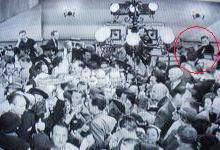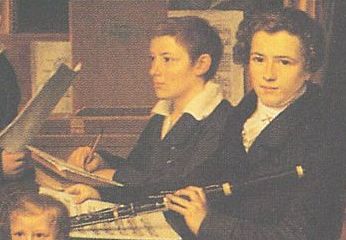

The multi-keyed simple system flute had evolved from the one key flute. The six open finger holes and the conical bore had been left as they were, under the fingers, and a variety of keys were added. The instrument was full of compromises. (Every musical instrument is, but some more than others.) Even with the numerous keys, there were problems. The instrument was still uneven: tone quality would vary from note to note. Some intonation was difficult. Some keys (modes) were quite awkward to play in.
Yet the flute was incredibly popular in the early 19th century. Writing in 1914, H. Macaulay Fitzgibbon says that the climax in popularity of the flute was reached about 1820–50. It was followed by a decline in popularity, he continues. That same period, 1820–50, is called "the brightest epoch in the history of the flute" by Leonardo De Lorenzo, in his My Complete Story of the Flute (1950).
Why was the flute so popular? Because of the sound and charm of the 19th century simple system instruments, defects and all. There were also, of course, other reasons, including portability, lack of need for tuning strings or working with reeds, availability of low cost instruments, and, importantly, fashion.
The 19th century simple system flutes are not well understood today, even now that the baroque flute has come to be an instrument appreciated and studied by many flutists.
One can read in contemporary books and articles that the pre-Boehm instrument has a tone that was "inferior" or "deficient in quality". This was not the opinion at the time. The flute may have had problems, but tone was not one of them. W. N. James compared Drouet's tone in 1829 to "pillars of crystal in the sunshine". Even reports from those who advocated the Boehm flute (but who knew the sound of the old flute as played by flutists who had learned on them) never criticize the tone of the 19th century simple system flute. On the contrary. For example, we can read in Fitzgibbon (1914), in a passage where he praises flute tone in general, that "The old flute had undoubtedly more of this characteristic mellifluous sound than the modern Böhm." We will make some technical comments on the sound of the conical flutes with small holes in the next section, and give more favorable comments on the sound in the last section on this page.
One can also read that the pre-Boehm type of flute "clearly could not fulfil the requirements of the nineteenth century". This is a modern conceit. All of 19th century music can be played on simple system flutes. Though a simple system flute is certainly not the best tool for French music from the end of the century conceived for the silver flute, it can be the right tool for Wagner and Brahms.
Another thing not well understood is how the old flutes were played. Among other things, one must study and use the numerous alternate fingerings if certain passages are to be done smoothly. Smoothness seems to have been tremendously important to many great 19th century players. Fingerings were chosen to avoid register breaks and to obtain a liquid sound. The difficulty on the simple system instrument of certain high passages in 19th century music has been misjudged by some modern authors, who have misunderstood the fingerings of the old flute. R. S. Rockstro, who knew both the old and new systems intimately, could write in 1889 that "The old flute, with eight keys and upwards, possesses certain facilities in the fingering of the third octave which are not afforded by any flutes on the open-keyed system [e.g. the Boehm flute]..."
Still, it was admitted even by partisans of the old flute that it was, especially in certain keys, more difficult to play well than a Boehm flute. W. Barge wrote in the preface to his method of 1880 for the nine-key flute that the Boehm's "easier tone production ... makes it possible that even the less talented can develop into quite competent players". Barge would appear to be feeling very defensive.
There is no way to describe in words the sound of the simple system flute in any substantial way. (We hope to have sound samples on this site in the future.) There is no such thing as a single "simple system sound", anyway. There are many types of instruments, with different conical bores, and hole positions and sizes, all of which greatly affect the sound and effect. And there were many players with very distinct styles. Still, we make a few general remarks at this point.
The tone of 19th century conical bore flutes with smallish holes is, as an oversimplification, between the baroque and modern flute, but closer to the baroque flute. The volume, too, is usually between that of the baroque and modern flute.
Data given in Philip Bate's The Flute (Ernest Benn Ltd., London, 1975) and elsewhere show that the number of strong upper harmonics in the tone of a cylindrical bore flute is significantly greater than on a conical instrument; the former will sound relatively rich, and the latter relatively pure. Some of this difference may be due to smaller holes on conical flutes, which tend to have a filtering effect on the high harmonics. Following are two graphs of the sound spectra of the note a' on a conical flute (in this case, a copy of a baroque flute) and a cylindrical flute, in a test I did myself. But, to be honest, the player has so much control over tone with the embouchure, in this context, that I could have made the graphs come out the other way around if I had chosen to.
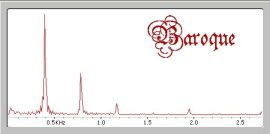

This phenomenon—fewer partials from a conical bore and small holes—seems to hold only for the low notes! A study by Anne Shreffler in the Galpin Society Journal (1983) indicates that the spectrum of the baroque flute richens as the pitch ascends, while on the Boehm flute the high notes become more pure, with fewer strong partials. The baroque flute behavior coincides precisely with my feelings about the 19th century conical, small or medium-hole flutes: the high notes on these instruments can have wonderful color and interest.
A number of opinions and comparisons of the sounds of simple system flutes, reform flutes, and Boehm flutes from German sources may be found in John Bailey's thesis; see the references.
In comparing the sound of the 19th century keyed flute to the Boehm or other types of flutes, it should be kept in mind that there are significant differences other than the basic timbre and the volume. The "noises" made by an instrument when a note starts, stops, develops, and/or transitions to another note are fundamental to the overall effect on the ears. I think the size of the holes makes a difference in these noises as well as tone and volume. The simple system instruments respond to articulation differently than modern flutes. The fact that a conical bore contains less air may explain some of the difference.
The slight variation in quality and strength from note to note on the old flute can be a nuisance in some contexts, but, on the other hand, this was praised by A. B. Fürstenau as a desirable property, one that is lost with the Boehm flute. This variation is in some ways similar to the variation in the quality of a singer's voice as different vowels are sung on different pitches, a not unpleasant effect. The use of a variety of fingerings, as Fürstenau recommends, can allow the old flute to have different "vowels" at the same pitch (though the flute will always remain monochromatic compared to the voice). When the old instruments are played with early techniques (including little or no vibrato, more frequent use of altered pitches, and an often more declamatory, less legato style), the contrast with modern flute sound can be quite striking.
The sounds of the old flutes are those that were in the ears of 19th century composers (with the exception of some composers in England and France in the second half of the century). When a Kuhlau trio or quartet, say, is heard on early 19th century flutes, the articulation and balance can be a revelation. But high quality instruments must be mastered, and played in sympathetic surroundings with appropriate accompaniment, before their affect can be appreciated or judged.
Claims that the extended range appearing in orchestral flute parts as the 19th century progressed was due to composers' exploiting the possibilities of the Boehm flute are misleading. While I am sure that some late 19th century composers consciously exploited the new flute's easier highest notes, it is simplistic to think that the Boehm flute's availablility was the initial cause for the extended range. Demands for extended range, by composers and virtuoso players, were made in the 19th century on all musical instruments.
By 1790 or so, flutes (whether one-keyed or multi-keyed) were expected to play up to a''' regularly, though the note could be difficult on some flutes (especially, in my opinion, English flutes from that period). This note became routine in the first flute part of orchestral works after 1800. The note b'''b was considered available in the early 19th century, but caused more difficulty. Tromlitz (1791) says it "appears infrequently", but includes it in his fingering chart. Hoffmeister's Prélude ou Exercise, op.35, of 1793 contains two high b'''bs. But the b'''b wasn't used by Beethoven until his Eighth Symphony (1814), and there are instances in that work where Beethoven drops the flute an octave to avoid that note. It appears in chamber music of F. Kuhlau and Gottfried Weber in the 1820s.
Schubert used b'''b in his orchestral flute parts, but at times consciously avoided it. Mendelssohn seems to have abstained from its use. Schumann used b'''b, and never went higher. Joachim Andersen's etudes, written for the simple system flute, do not go higher than this b'''b.
But there were many higher notes written for the old flute. High notes appear first in fingering charts, and fantasies, virtuoso etudes, or showpieces composed by flutists. Later they appear in "standard repertoire". Fingerings for the one-key flute up to d'''' appeared in the supplement to Diderot's encylopedia (1777). Charles Nicholson's Complete School for the Flute of 1836 includes e''''b . . .
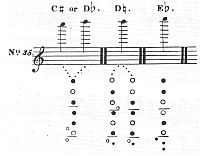
Fairly early appearances of the note b''' in musical works include those in works of J. Demersseman (1833–1866), C. Ciardi (1818–1877), and in G. Briccialdi (1818–1881), e.g. his op.36 duet of 1846. Charles Keller includes both b''' and c'''' (though with an ossia an octave lower) at the end of the first of his Trois Fantaisies, Op.51, of circa 1844. When Brahms wrote high b'''s and c''''s in his Second and Fourth Symphonies (1878 and 1886), he most likely expected to hear them played on simple system, Meyer-type flutes.
Mahler and R. Strauss worked with many kinds of flutes; some of the b'''s and c''''s they wrote would have been attempted by simple system flutes. (And some by reform flutes or Boehm flutes; we will speak of this period elsewhere.) The theses of Amy Hamilton and John Bailey contain more about the types of flutes used in Germany and Austria at the end of the 19th century; see the references.
Appearances of low b in (even late) 19th century flute music almost invariably indicate writing for the simple system flute. The B-foot is not common on 19th century Boehm flutes, while it was quite common on serious German or Viennese simple system flutes well before midcentury. (However, we remark that France Zierer, first flutist of the Vienna Philharmonic in the 1840's, is reported to have played a six-key flute without c' or c'#. Low notes were more necessary for chamber music more than orchestral work, as a rule.)
A list of over a hundred flute pieces in which low b appears may be found at http://www.larrykrantz.com/lowb.htm. There are surely hundreds more from mid-19th century Germany and Austria. The B-foot was first popular in Vienna. We find the low b only once in the variations on Trockne Blumen that Schubert wrote in 1824 for the virtuoso Ferdinand Bogner, but, curiously, it was used twelve times in an early version of Variation V that Schubert later replaced with the one known today. Carl Czerny's Introduction, Variationen e Finale, Op.80, for flute (or violin) and piano, published the next year in Vienna, has fourteen instances of the note b.
Notes below b usually indicate that long Viennese-style simple system flutes were expected. Low bb occurs in flute parts of Mahler's Fourth and Fifth Symphonies and Balikirev's Second Symphony. Bb-footed 19th century Boehm flutes are rare. (But A. G. Badger of New York did make Bb-footed Boehm flutes, and probably Sidney Lanier had such a flute when he played his Wind-Sing of 1874 in which there are three occurences of low a#.)
Guilio Briccialdi (1818–1881) presumably played an Italian or Viennese style flute with an A-foot in 1846 when his Duo concertant, op.36 appeared. Low a and a# occur a number of times in both flute parts. Here are three excerpts from the first flute part of the long andante:
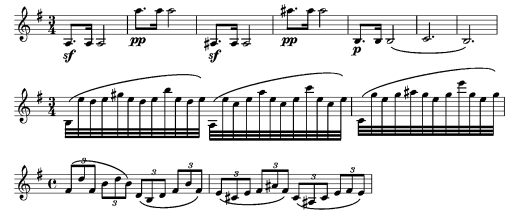
(The year after Op.36 was published, Briccialdi visited Boehm in Munich and soon adopted the Boehm flute. He later rejected that, in turn, for his own cylindrical design.)
There is only a single note below b in Czerny's 1825 Introduction, Variationen e Finale, Op.80. In a dramatic moment in the finale, we find in the flute part:

Perhaps Czerny simply intended this as a double stop for the violin alternative to flute, but a player of the Viennese panaulon (G-foot flute) would probably have tried to play the low g.
There is much that can be said about 19th century performance practices (articulation, slurs, dynamics, tempo, etc.) in general. Our interest is with the flute, and at this point we mention only a few effects that work well on, or which require, simple system flutes.
Finger vibrato is the first thing that comes to mind. One can imagine that this has been used ever since there have been wind instruments with holes. It can be done to some extent even if ring keys or perforated keys are present, but works best with unencumbered open holes. This is a wavering of the tone caused by partially covering the sounding hole, or partially or completely covering and uncovering an open hole further down the tube. It was one of the favorite effects of Charles Nicholson; the English term was "vibration". Finger vibrato can be controlled far more extensively than breath vibrato, both with regard to speed and intensity. Nicholson suggested a speeding up as the intensity diminishes, when time permits. The following is from his Preceptive Lessons of 1821. (Click for a larger version.)
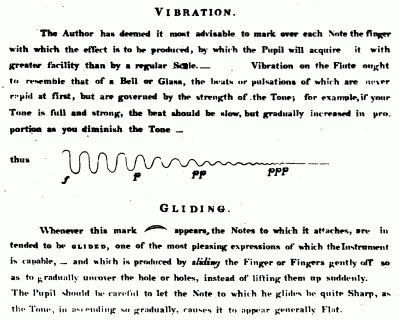
Another favorite device of Nicholson and some English players was the "glide", a type of portamento also used, along with vibration, by some players of traditional Irish music today. It is produced by sliding a finger or fingers off (or sometimes on) one or more holes to produce a continuous change of pitch. Some jazz flutists manage it on modern flutes.
One must be careful about overuse of these devices. It is doubtful that they were used in orchestral playing. There is less evidence of the popularity of these ornaments outside England, but the use of both devices is illustrated, for example, by Fürstenau in 1844. Fürstenau also discusses breath vibrato. He illustrates both types of vibrato in examples from his own solo compositions. In these examples, as a rough estimate, he indicates vibrato on one note in every eight measures.
Alternate fingerings seem to be far more acceptable-sounding on the simple system than on a Boehm or other large-holed cylindrical flute. I am not sure why this is, although it is no doubt in part simply because the simple system flute is less tonally even to begin with, so additional inequality is not unpleasant. Modern taste forbids the regular use of "fake fingerings" on the Boehm flute, but alternate fingerings are an essential part of the technique on the old flute. Rockstro (1889), for example, gives 12 fingerings for f'''#. Fürstenau (1844) gives nine fingerings for c'''.
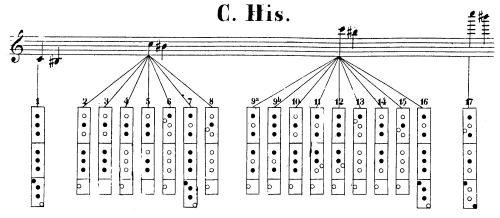
Some alternate fingerings are used in trill fingerings, but many are for either color change or to make the sound smoother, either by easing the difficulty of the fingering in some context and/or by avoiding register breaks. And some were for expressive playing with intonation. A sensitive fingering would purposely change the pitch of a note, producing a sharpened form of the note, often about 1/3 of a semitone higher than one would expect the written note to be. One of the reasons J.-L. Tulou gave for rejecting the Boehm flute was the issue of "having enough altered notes in order to be able to adjust the leading notes".
Here are a few examples of alternate fingerings. Fürstenau suggests sometimes playing a'' with 12-456 and the low C# key; this sounds a bit like the a'' on a renaissance flute, smooth and sweet. It is too sharp without the C# key, but was still used in that form as a sensitive note between two b''bs fingered 12-456k, for example, or in a turn c'''-b''b-a''-b''b, with that b''b fingering. Monzani suggests a'' fingered as 123456 with the G# key, when alternating with G#. This is a bit clicky, but effective.
Nicholson suggests playing g'' with 12345-k with the G# key, the short F key, and the D# key, when in F minor. (This won't work with a small-holed flute or one with the G# key on the lower center.) The note tends to be sharp and a bit veiled, but it has a good effect. Try playing f''-g''-a''b-g''-f''-a''b-g''-f'' several times using the normal g'' and this alternate g'' (keep the F key down for the entire passage). The softer second step in the F minor scale seems appropriate.
Here is a suggestion of Tulou for the turn on b'' with c''' and a''#. It works well on a one-key flute, but if a long C key is present, many players will just use it with the normal b''. Notice (if you have a flute to try this on) how sharp the "sensitive" a''# is.
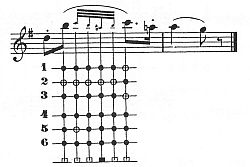
Most alternate fingerings are for the high notes, at the top of the second octave and in the third. In the second half of the 19th century, the use of a large number of alternate fingerings began to diminish.
Our topic on this site is more that of flutes than flutists, but it is useful and interesting to know what types of flutes were used by major players and in major orchestras. Some information can be found in short biographies of flutists in Rockstro, De Lorenzo, and W. N. James, and also in the theses of Amy Hamilton and John Bailey (see the references).
We collect some odds and ends here about players of simple system flutes from the mid or late-19th century. These were chosen because they mention either the construction of, or the tone of, their flutes.
Robert Frisch (1805–1865) as a young man was solo flute in the orchestra of Johann Strauss Sr. He came to England in 1838. Rockstro reports that Frisch had
...complete mastery over his instrument and executed the greatest difficulties with...graceful ease. ... Frisch played on an old-fashioned flute of German make, with numerous keys including one for b and an extra c'# lever for the little finger of the left hand.
Beethoven's Ninth Symphony was premiered (1824) at the Kärntnerthor Theater in Vienna when one Sedlatzek, who played a G-foot panaulon, was principal flutist. Sedlatzek later moved to England and Rockstro tells us that
The well-known Sedlatzek played on a flute of this kind [with a G-foot] made by Koch.... It is said that on one occasion only, Sedlatzek succeeded in sounding the g, and that he was so delighted at this unexpected success that he stood the flute up in a corner and saluted it with a profound obeisance.
Cesare Ciardi (1818–1877) spent most of his career in St. Petersburg. John Finn wrote that
A good many years ago he came to this country [England] and when brought before Rudall he produced a cracked old boxwood instrument upon which he commenced to play with such clear, beautiful tone, faultless elegance and taste that Rudall...declared to that ardent amateur, Walter Scott Broadwood, that "he is fit to play before a chorus of angels!"W. S. Broadwood describes the same incident and gives us the valuable information that Ciardi played a Viennese style instrument.
He played on an old wooden instrument by Koch (I think) of Vienna, with a crack down the head joint, which, as I remember, much excercised Mr. Rose [of the Rudall & Rose firm]...
Ferdinand Buchner (1825–1912) spent much of his career in Russia. According to De Lorenzo, "Buchner always played an old-style flute and preferred one of Vienna manufacture for his own particular uses".
After leaving the Vienna Conservatory in 1852, Adolf Terschak (1832–1901) became a touring virtuoso. Terschak is reported to have played a sixteen-key flute with a G-foot (a panaulon) made for him by J. Zeigler in Vienna in 1850 for his entire career.
Ernesto Koehler (1849–1907) was born in Italy, and after two years in Vienna, went to St. Petersburg. After receiving some etudes from De Lorenzo, he wrote to the latter that "with the modern flute which you are using, they must be more practical than with my old instrument". Koehler was admitting that some things were easier to play on the Boehm flute, but, ironically, De Lorenzo was at that time playing a 13-key flute made in Milan.
De Lorenzo met Abelardo Albisi (1872–1939) in 1907 and reports that
He confessed to me that if everyone could play on the old system flute as [Antonio] Zamperoni [1844–1909] played it, there would have been no reason for the Boehm flute! The perfect intonation in the whole register of the instrument and particularly, its marvelous tone, were little short of miraculous.Albisi was Zamperoni's replacement at La Scala Opera House. De Lorenzo goes on to say that a friend and admirer of Zamperoni once wrote him
They say that the young man who replaced Zamperoni is fine and very able, but to me the tone of his modern flute, compared with that of Zamperoni, sounds like an ocarina!
Albert Fransella (1866–1934) was born in Amsterdam but spent his career in England. He played a modern flute. De Lorenzo wrote that
It was [Fransella's] opinion that the old conical eight-keyed flute is very sweet in timbre and that the tone which he in his youth heard Dahmen (the principal flutist in Amsterdam at the time) produce is never to be forgotten.
Here is one last player, who is not 19th century and whose name I do not know. He just caught my eye in the dance hall scene in Charlie Chaplin's 1936 movie Modern Times. He has a wooden flute with an ivory head, common for simple system flutes at that time (though since one cannot see the keys in these screen captures, we cannot be 100% sure of what he is playing).
